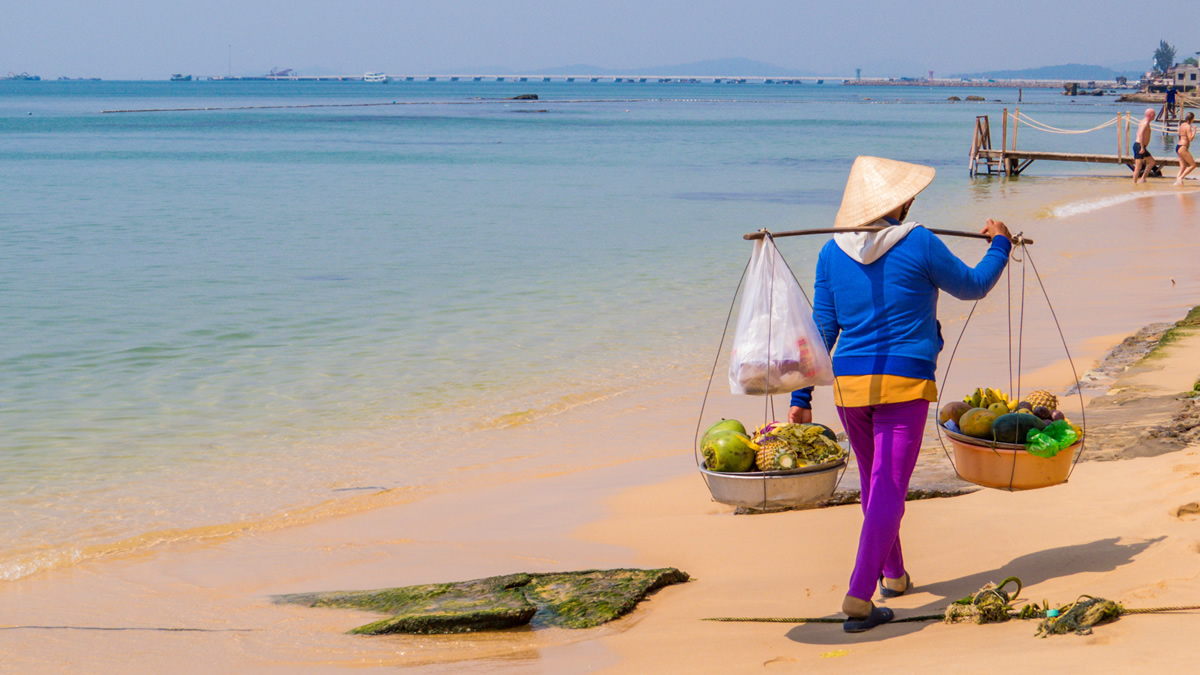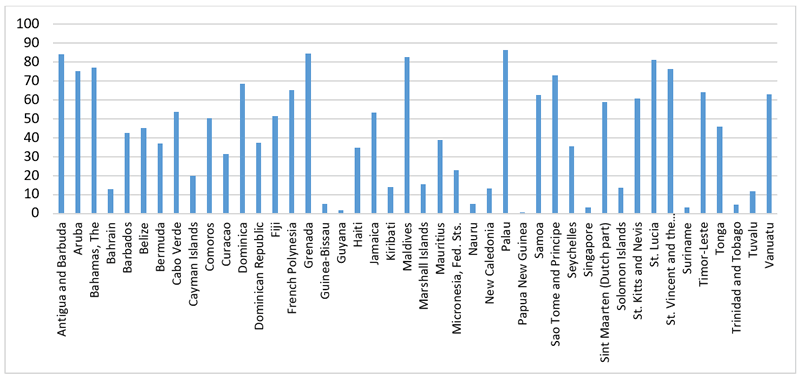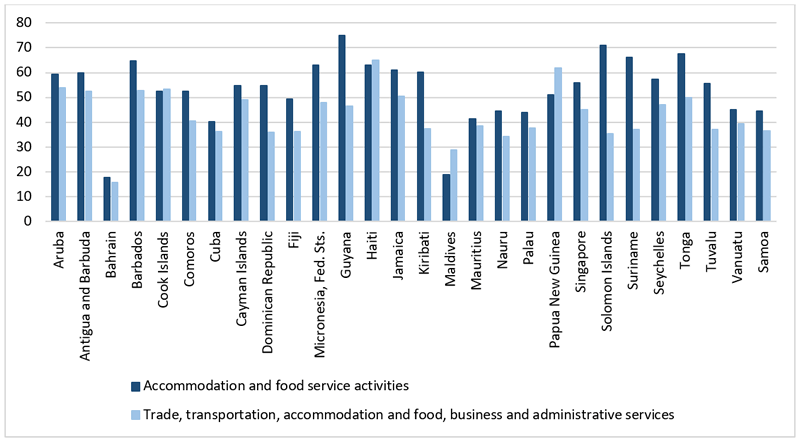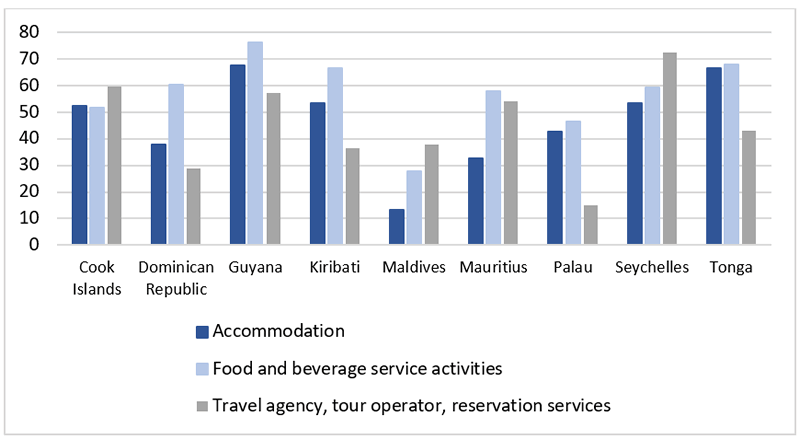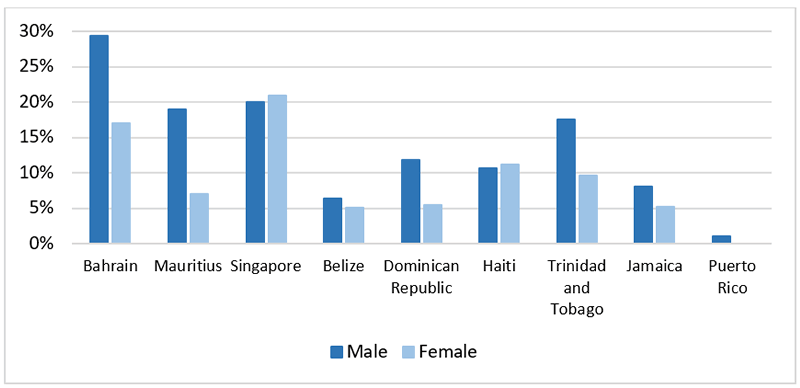Written by Simonetta Zarrilli of UNCTAD and Nursel Aydiner-Avsar, Associate Professor, Akdeniz University
Women make up the bulk of mainly low-skilled workers in the tourism industry on small island developing states (SIDS). But are they being catered for and what should be done to protect them from the economic and social fallout from the coronavirus pandemic?
The impact of the COVID-19 pandemic on women working in the tourism industry in SIDS is disproportionate but so is the emerging policy response which lacks an explicit gender component.
Right now, tourism has ground to a halt globally and for many SIDS this is their only economic lifeline.
The United Nations World Tourism Organization (UNWTO) reported that during the first quarter of 2020 $80 billion were lost in export revenues from tourism and there were 67 million fewer arrivals as compared to the same period of last year.
Moreover, by April 2020 100% of worldwide destinations had put travel restrictions in place.
According to the UNWTO’s current scenarios, international tourist arrivals could decline between 58% and 78% in 2020, which would translate into a loss of up to $1trillion in international tourism receipts.[1]
The International Air Transport Association’s (IATA) figures confirm this drop off, reporting an 80% fall in flights by early April.[2]
Then the World Travel & Tourism Council calculates that over 100 million jobs in tourism and travel are currently at risk[3]
For SIDS, putting tourism-related activities to a standstill is expected to have devastating consequences. Tourism provides more than half of total export revenue in 20 SIDS and more than 30% in 29 SIDS.
Tourism also supports employment generation both directly through hotels, restaurants, travel agencies, aircrafts, cruises, resorts, and shopping outlets; and indirectly through its multiplier effects on restaurant suppliers, construction facilities, and handicraft producers, among others.
International tourism, receipts (% of total exports) in SIDS
Source: World Development Indicators database (accessed on 11 April 2020)
Note: Data are for 2018 for all countries except Cayman Islands, Kiribati, Palau and Papua New Guinea (2017), Aruba, French Polynesia, and New Caledonia (2016), Micronesia, Fed. State of (2014), and Barbados and Tuvalu (2013).
Women in tourism
Across the world, women make up most workers in the tourism industry, though they tend to be clustered in low-skilled jobs. Women constitute more than half of those employed in the accommodation and food services sectors – the core tourism-related economic activities – in 20 out of 28 SIDS for which data are available.
Women are more likely to be entrepreneurs in tourism than in other sectors of the economy thanks to lower entry barriers.
Their enterprises, however, are mainly small-sized.
UNWTO and UN Women report that in Anguilla and Trinidad & Tobago, for example, women entrepreneurs are the double than in other sectors, and more than twice in Mauritius as a share of total employers.
Female share of total employment in the selected sectors in SIDS (% share)
Source: ILOStat database (accessed on 9 April 2020)
Note: Data are presented for the latest available year for each country in ILOStat.
Economic contraction of tourism to SIDS is likely to hit women hardest
Under the economic pressures of the COVID-19 pandemic, enterprises are inclined to first lay off workers in low-skilled, casual, seasonal and informal jobs while keeping those in high-skilled or permanent positions.
Given the highly female-intensive nature of employment in tourism, especially in low-skilled activities, women are likely to be hit the most by job losses in SIDS.
For example, women have the highest share of employment in food and beverage service sectors in Dominican Republic, Kiribati, Mauritius and Tonga.
On the contrary, travel agency, tour operator and reservation services sectors, relatively high-skilled activities, show the lowest presence of women in the same countries.
Firms, as coping strategies, may also choose to lower wages or shift workers to informal or part-time work arrangements, worsening the already unclear terms of employment in tourism.
Female share of employment in selected tourism-related economic activities in SIDS (% share)
Source: ILOStat database (accessed on 9 April 2020)
Note: Data are presented for the latest available year for each country in ILOStat.
In addition, the survival of firms, and especially small and medium sized enterprises, is at risk as the economies contract.
Access to credit is critical for firms’ survival in crisis times. There is a significant gender gap in access to business credit in Bahrain, Mauritius, Dominican Republic, Trinidad and Tobago, and Jamaica among the nine SIDS for which data are available.
This implies that, in the absence of targeted policies, women entrepreneurs in tourism face a higher risk of business closures and bankruptcy than their male counterparts.
Share of population ages 15+ who borrowed to start, operate, or expand a farm or business, by sex (% share)
Source: Global Findex database (accessed on 12 April 2020)
Note: Data are for 2014 in Belize, Jamaica and Puerto Rico and 2017 for the rest.
The resulting fall in incomes due to job losses and business closures in tourism implies a higher incidence of poverty especially for women.
Women would also face an increase in their already unequal share of unpaid domestic and care work as many services such as education, childcare, and healthcare, have been interrupted during the pandemic.
Policy recommendations
There are several immediate actions that can be taken to mitigate the negative impacts of the coronavirus pandemic on women in tourism on these small islands.
Targeted policies must incorporate a gender perspective to address these gender gaps, examples of which include:
-
Workers/employees. Policies are needed to prevent job losses in tourism for both men and women employees/workers. Such polices include incentive programmes for job retention through wage subsidies and/or social security and other fiscal payment reliefs. Income support schemes such as unemployment benefits need to be given or extended. They should cover the formal and informal sector where disadvantaged groups, including women, are highly represented.
-
Own-account workers. Direct income support and cash transfers are necessary to overcome the loss of income-generating activities for own-account workers, a category that includes many women.
-
Tourism enterprises/employers. There is also an immediate need to prevent closures and bankruptcies of tourism enterprises through monetary and fiscal policy measures. They include measures to ease the liquidity constraints of enterprises through sectoral funds, social security and fiscal payment exemptions or deferrals, fast and subsidized loans, relaxation of regulations and taxes on travel and tourism activities.[4]
Special credit lines could be introduced for women tourism entrepreneurs in SIDS, and national and local governments can give priority to women-owned enterprises in public procurement.
Medium-term strategies
Crucially, the economic crunch will certainly make tourism an unaffordable option for many. Moreover, social distancing measures may be in force for an unknown period. This implies the need for SIDS to adopt strategies beyond immediate reactions.
-
Infrastructure programmes. Initiatives should be designed to prepare the sector for the post-recovery era. The forced pause can be used to develop strategies to enhance linkages between the tourism sector and local infrastructure, products and skills to make the overall economy more resilient. These programmes should incorporate a gender perspective and be developed with women's participation.
-
Education and training programmes. These should be put in place for displaced workers in the tourism sector to enhance their competence. Skill development programmes will also be needed for entrepreneurs to upgrade their activities.
-
Beyond Tourism. For all tourism actors, training programmes should go beyond tourism to alleviate the dependence on tourism and spearhead economic diversification.
What is currently happening in SIDS?
Many SIDS have introduced, or at least expressed the intention of introducing, fiscal and/or monetary/macro-financial measures to fight the negative economic impacts of the pandemic.
Some SIDS have also introduced measures targeting the tourism sector. For example, loan guarantees for tourism and transport sectors were put in place in Cabo Verde, Tonga introduced short-term financial support to all affected sectors including tourism, Grenada payroll support put in place to the affected sectors, notably tourism and Trinidad & Tobago made available grants to hoteliers to upgrade of their facilities, as of 7 May 2020.[5]
However, none of them include an explicit gender component. All SIDS need to take immediate action to mitigate the negative impacts of the pandemic on tourism and be responsive to the specific difficulties that women experience.
Development assistance to support the tourism sector in countries highly dependent on it, such as SIDS, should be deployed following the same gender-responsive approach.
Related link:
[1] UNWTO. 2020., World Tourism Barometer May 2020, Special focus on the Impact of COVID-19 Madrid.
[2] IATA. 2020. Covid-19 updated impact assessment, 14 April.
[3] WTTC. 2020.WTTC now estimates over 100 million jobs losses in the Travel & Tourism sector and alerts G20 countries to the scale of the crisis , Press release, 24 April.
[4] UNWTO (2020) . Supporting Jobs and Economies through Travel and Tourism: A Call for Action to Mitigate the Socio-Economic Impact of COVID-19 and Accelerate Recovery, Madrid.
[5] Based on a review of IMF’s coverage of policy response to COVID-19 available at https://www.imf.org/en/Topics/imf-and-covid19/Policy-Responses-to-COVID…

